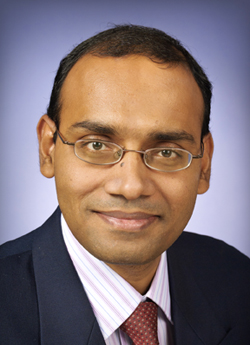 Lead Researcher Santosh Kumar
Lead Researcher Santosh Kumar
Just one year into the four-year Mobile Sensor Data-to-Knowledge (MD2K) initiative, research project academics at 11 different universities have undertaken to identify adverse health events and risk factors using mobile sensor data. The group has already been able to build computational models that identify a risk factors for stress as well as ways to identify when someone who has quit smoking has started again.
MD2K first launched in October 2014 with a $10.8 million grant from The National Institutes of Health (NIH). The investment was a portion of a larger grant the NIH awarded as part of its Big Data to Knowledge (BD2K) initiative, which received a total of $32 million to find more uses for biomedical research data.
When the initiative was first announced, University of Memphis computer scientist Santosh Kumar, who is the lead researcher, said during the first year of the initiative the team planned to develop a platform on which to conduct the study and in following years they would recruit participants in waves for congestive heart failure and smoking cessation studies.
Now, a year later, this software platform will soon be released by MD2K. The offering, which is open source, is designed for use on smartphones. Researchers and industry professionals will be able to use it to collect, analyze, visualize, and interpret mobile sensor data for health.
He also said that wearable devices the researchers will use in the study include a chest strap called AutoSense that measures ECG, respiration, and skin temperature; a wristworn activity tracker; radiofrequency sensor; smart glasses that offer near real-time tracking of the eye and its field of view; and GPS available through smartphones. All devices except the GPS-embedded smartphone were developed by the researchers.
Kumar told MobiHealthNews this week that the only change to the devices they first started with was they switched out their own activity tracker device for the Microsoft Band. One reason for this, he explained, is that the Microsoft Band offers a variety of other sensors their band didn't have.
In this first year, researchers also published 59 articles. Two such articles explored the detection of smoking lapses and stress. One of the articles, published in ACM UbiComp, detailed a computational model, called puffMarker, that automatically detects when a smoker who recently quit lapses for the first time. Data used to assess this includes hand gestures from the smartwatch and breathing signatures from a respiration sensor.
The significance of this, Kumar said, is that previously it was difficult to pin point the moment that someone starts smoking again after quitting and researchers had to rely on self-reported data which is often inaccurate. But with the puffMarker system, researchers will be able to identify when the user smokes for the first time and as a result more accurately identify the predictors leading up to the first puff.
“Development of the puffMarker model has fulfilled a longstanding need in smoking cessation research to precisely pinpoint the timing of first lapse," Kumar said. "This work has opened the doors to discover potent markers in the data collected by mobile sensors that can be used to deliver just-in-time mHealth intervention to improve smoking cessation rates."
The other paper offered a computational model, called cStress, that detects stress from heartbeats and breathing patterns. The researchers found that this model was informative and actionable in improving interaction among couples.

















